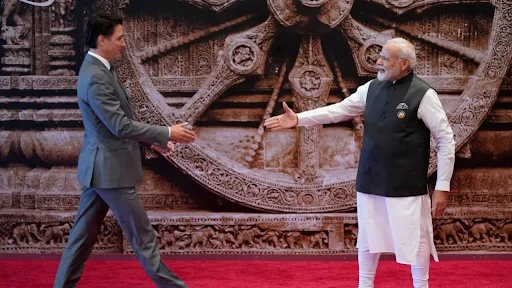Introduction
- Justin Trudeau’s resignation as Canada’s Prime Minister marks a key moment in the relationship between India and Canada, reflecting the broader changes in the political landscape.
- The political developments under Trudeau have contributed to shaping the dynamics of these relations, which have seen both periods of cooperation and significant tensions.

The History of India-Canada Relations
- Early Diplomatic Ties:
- India and Canada established diplomatic relations in 1947, shortly after India’s independence.
- This early phase was rooted in shared values such as democracy, pluralism, and human rights, laying the foundation for strong people-to-people connections.
- The two countries were optimistic about the future, with both parties seeking to build a relationship based on these mutual democratic ideals.
- Political Strains and Tensions:
-
- Despite the positive diplomatic foundation, political relations between India and Canada have faced periods of strain, particularly in the latter half of the 20th century.
- Kashmir and the Plebiscite: Canada’s support for a plebiscite in Kashmir in 1948 created early friction, as it conflicted with India’s stance on the region.
- Nuclear Disputes: Canada’s opposition to India’s nuclear tests in 1974 and its reluctance to endorse India’s position on the Non-Proliferation Treaty (NPT) and the Comprehensive Test Ban Treaty (CTBT) further fueled tensions.
- The Khalistan Issue: The most persistent issue in bilateral ties has been Canada’s perceived leniency toward the Khalistani movement. This has consistently strained the relationship, particularly after the 1980s.
Read also: A Comprehensive Guide to Collective Farming for UPSC Aspirants
- Strengthening Relations Under Harper’s Leadership:
- The period under Canadian Prime Minister Stephen Harper from 2006 to 2015 marked a renewal of relations, with a focus on trade, investment, and bilateral cooperation. Harper’s tenure saw 19 high-level visits from Canada to India and the joint celebration of 2011 as the Year of India in Canada.
- Prime Minister Narendra Modi’s visit to Canada in 2015 was a historic moment, elevating the relationship from a bilateral to a strategic partnership. However, the issue of Khalistani separatism remained a sensitive subject.
- Recent Diplomatic Tensions:
- Following 2015, relations began to deteriorate again, largely due to the continuing presence of Khalistani elements in Canada. Key events that exacerbated tensions include:
- The Jaspal Atwal Incident: In 2018, the invitation of Jaspal Atwal, a convicted terrorist, to a dinner with Justin Trudeau during his visit to India led to significant backlash in India.
- Farmers’ Protest Support: In 2020, Trudeau’s remarks about the Indian government’s handling of the farmers’ protests were interpreted as support for separatist movements, further complicating relations.
- 2023 G20 Summit: During the G20 summit, Prime Minister Modi raised serious concerns over the continued anti-India activities of extremists in Canada, reinforcing the diplomatic rift.
- The Khalistan Issue: A Long-standing Source of Tension
- The Khalistan movement has long been a contentious issue between India and Canada, especially since the 1980s.
- 1982: Prime Minister Pierre Trudeau (Justin Trudeau’s father) declined to extradite Talwinder Singh Parmar, a key figure in the Khalistan movement, despite his involvement in the killing of Indian police officers.
- 1984 Operation Bluestar: The Indian Army’s operation to remove militants from the Golden Temple in Amritsar in 1984 bolstered the Khalistan movement among the Sikh diaspora, particularly in Canada.
- 1985 Air India Bombing: The bombing of Air India Flight 182, resulting in 331 deaths, many of them Canadians, further exacerbated tensions. The accused were linked to Khalistani extremists.
- Post-2015: Justin Trudeau’s proximity to Khalistani supporters and his government’s stance on issues related to Sikh extremism has perpetuated the diplomatic challenges between the two nations.
Key Concerns in India-Canada Relations
- Trade and Economic Impacts: The diplomatic tensions have delayed progress on the Comprehensive Economic Partnership Agreement (CEPA), which was expected to boost trade ties between India and Canada. Bilateral trade currently stands at just $5 billion, and the diplomatic rift threatens this relationship.
- Uncertainty in Investment: Canada has been a major investor in India, with Canadian pension funds investing over $75 billion in key Indian companies. In 2023, Canadian pension funds like the Canada Pension Plan Investment Board (CPPIB) and the Caisse de dépôt et placement du Québec (CDPQ) collectively invested more than $75 billion in Indian companies such as Paytm, Zomato, and Infosys. These investments have been crucial in expanding India’s tech and infrastructure sectors. However, with the escalating diplomatic tensions, the future of such investments has become uncertain.
- Impact on Remittances: Canada is one of the leading sources of remittances to India, a lifeline for millions of families. In 2021-22, India received approximately $125 billion in remittances, with Canada contributing around 0.6% of that total. This means that approximately $750 million came from the Indian diaspora in Canada.
- Education and Student Mobility: Canada has long been a popular destination for Indian students, with over 427,000 Indian students enrolled in Canadian institutions in 2023. According to the Canadian Bureau for International Education, Indian students make up a significant portion of the international student population in Canada, contributing an estimated $4.6 billion annually to the Canadian economy through tuition fees and living expenses. However, the ongoing diplomatic fallout may disrupt this educational exchange
The Significance of India-Canada Relations
- Strategic Cooperation in the Indo-Pacific: Canada views India as a key partner in the Indo-Pacific region, aligning on shared concerns about China’s growing influence. For example, Canada has supported India in its efforts to assert a more significant role in regional security dialogues, such as the Quad (Quadrilateral Security Dialogue), which also includes Japan and Australia. Canada’s involvement in the Indo-Pacific Strategy, released in 2017, specifically identifies India as a strategic partner for promoting peace, stability, and prosperity in the region. Additionally, Canada has backed India’s position on maintaining a rules-based international order, particularly in countering China’s assertiveness in the South China Sea.
- Trade and Economic Cooperation: Canada is India’s 10th-largest trading partner, with trade between the two countries growing steadily over the years. Canadian companies, such as the multinational energy giant Enbridge, have investments in India’s energy infrastructure, including renewable energy projects.
- Development Assistance: In 2018-2019, Canada contributed nearly $24 million to support over 75 development projects in India, many of which were aimed at improving healthcare access, sanitation, and rural education. Canadian nonprofits and development agencies, such as Grand Challenges Canada, have been instrumental in implementing projects aimed at maternal and child health in rural areas. For example, the initiative “The Innovation for Maternal and Child Health” works to reduce infant mortality in some of India’s most underserved regions. Additionally, Canada has helped facilitate clean water projects in rural India like the India-Canada Water Partnership (ICWP) aligning with India’s commitment to the UN Sustainable Development Goals (SDGs). Canada also has supported water and sanitation projects in regions like Rajasthan, where water scarcity is a significant issue.
- Energy and Space Cooperation: The two countries have cooperated in the nuclear energy sector, with Canada providing uranium to India. In the energy domain, Canada has been a critical supplier of uranium to India, with both countries having signed a Nuclear Cooperation Agreement (NCA) in 2010. This agreement enables Canada to provide uranium for India’s civilian nuclear power program, helping India meet its growing energy demands.
- In the field of space exploration, ISRO (Indian Space Research Organisation) and the Canadian Space Agency (CSA) have collaborated on various projects, most notably in the area of satellite launches.
- Since 2015, India has launched several Canadian satellites using its Polar Satellite Launch Vehicle (PSLV). For instance, in 2019, India successfully launched 14 satellites, including 13 Canadian ones, marking a significant milestone in bilateral space cooperation.
- Educational and Diaspora Relations: The Indian diaspora in Canada, which numbers over 1.6 million, plays a crucial role in strengthening bilateral relations. The community contributes significantly to Canada’s cultural, economic, and political life, with notable figures such as the former Governor General of Canada, Michaëlle Jean, who is of Haitian-Indian descent, exemplifying the integration of the Indian diaspora into Canadian society. Educational exchanges, along with academic collaborations between Canadian and Indian universities, such as the partnership between the University of Toronto and the Indian Institute of Technology (IIT), further solidify the educational ties between the two countries.
Challenges in the Bilateral Relationship
- Khalistani Separatism: The Canadian government’s perceived tolerance toward Khalistani separatists remains the most significant challenge in India-Canada relations. This issue continues to overshadow economic and cultural ties. The most glaring example of this was during Justin Trudeau’s 2018 visit to India, when Jaspal Atwal, a convicted terrorist linked to the assassination attempt of an Indian minister, was invited to an official dinner, sparking outrage in India.
- Violence Against Indian Diplomatic Missions: Attacks on Indian consulates and temples in Canada, often linked to extremist groups, have further strained relations between the two nations. In 2015, Indian diplomatic missions in Canada were targeted by protesters who were allegedly supporters of the Khalistan movement, highlighting the vulnerability of Indian assets in Canada. More recently, in 2018, a series of attacks on Indian temples in Canada, including vandalism of sacred statues, brought further attention to the problem of extremist violence.
- Trade Barriers and Negotiations: Structural impediments such as complex labor laws, market protectionism, and bureaucratic hurdles have long hindered the progress of trade negotiations between India and Canada, particularly with regard to the Comprehensive Economic Partnership Agreement (CEPA) and the Foreign Investment Promotion and Protection Agreement (FIPA).
One significant trade barrier has been India’s reluctance to fully open its agricultural market, especially for dairy and poultry products, which Canada has heavily lobbied to gain access to. - Canada-China Relations: Canada’s growing ties with China have complicated its relations with India, especially as both countries compete for influence in the Indo-Pacific region. One of the most prominent examples of this is Canada’s involvement in China’s Belt and Road Initiative (BRI), a massive infrastructure development project that India has been critical of due to its implications for regional security.
See more: Minimum Support Price (MSP) – Key for UPSC Preparation
Way Forward
- Engaging the Sikh Diaspora Constructively: India must engage more effectively with the Sikh diaspora, addressing concerns around the Khalistan issue and promoting a peaceful narrative about Punjab.
- Developing a New Framework for Cooperation: A pragmatic approach to bilateral relations is needed, focusing on mutually beneficial sectors such as trade, energy, and infrastructure, which can strengthen the partnership.
- Dehypenating Political and Economic Issues: Both countries should separate their political differences, such as the Khalistan issue, from their trade and economic relations. Negotiations on the Free Trade Agreement (FTA) should be resumed to boost bilateral trade.
- Promoting Civil Society and Track II Diplomacy: Encouraging dialogue through civil society initiatives and Track II diplomacy can help resolve longstanding issues and foster people-to-people connections.
- Responsible Media and Public Diplomacy: Both countries should ensure that media representations reflect the complexities of their relationship and highlight the positive efforts being made to strengthen ties.

